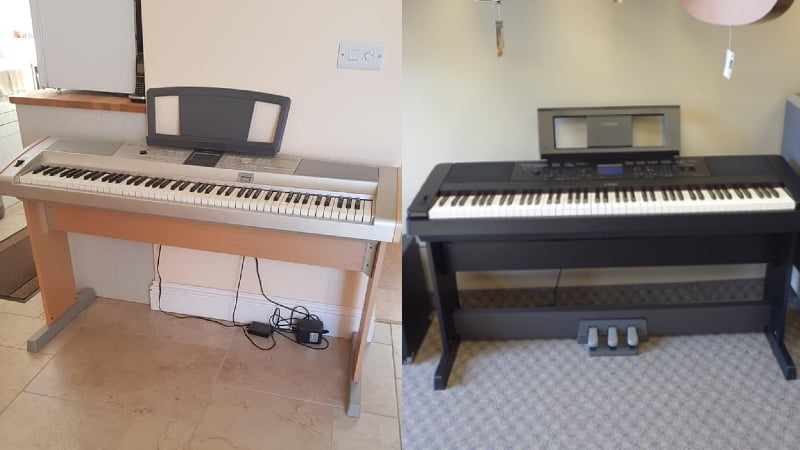The Yamaha DGX-660 is miles ahead of its predecessors. Find out why it’s one of the best digital pianos on the market in this Yamaha DGX-505 vs 660 comparison.
Upon its release, the Yamaha DGX-505 was considered one of the best digital pianos available. However, a lot of time has passed since then, and Yamaha has released a range of highly functional modern keyboards that may offer some more value for the money.
A great example of this is the DGX-660. While it’s part of the same product line, the DGX-660 is very different from the DGX-505. It comes with better tones, feels more like an acoustic piano, and is arguably one of the top digital pianos on the market today.
But what exactly did Yamaha add to the DGX-660?
Well, the brand added tons of features to this model. And in this Yamaha DGX-505 vs DGX-660 comparison, I’ll explain all of the new features you’ll find on the DGX-660 and what makes it one of the best digital pianos for the money today.
And by the end of the article, you’ll know exactly which digital piano to buy to satisfy your needs.
Yamaha DGX-505 vs 660: Comparison Chart




Last update on 2025-07-13 / Affiliate links / Images from Amazon Product Advertising API
Yamaha DGX-505 vs 660: A Head-to-Head Comparison
While the DGX-660 and DGX-505 are very different from each other, I chose to look at three qualities to really illustrate how much better the DGX-660 is. I compared these pianos based on their tone, feel, and polyphony, which is some of the most important characteristics of any digital piano.
And after rigorous testing, the DGX-660 won every category with a final score of 3-0. Below, I’ll get into the details of both pianos so you can see how much better the DGX-660 is compared to the DGX-505.
Tone
The winner: Yamaha DGX-660
The very first feature I considered was the tone. Before you judge the feel and other qualities of a digital piano, you have to hear how they sound. And when I put these two pianos up against each other, the DGX-505 had no chance. The Yamaha DGX-660 not only has a better tone engine, but it has a superior sound library, so it won the point for the tone comparison.
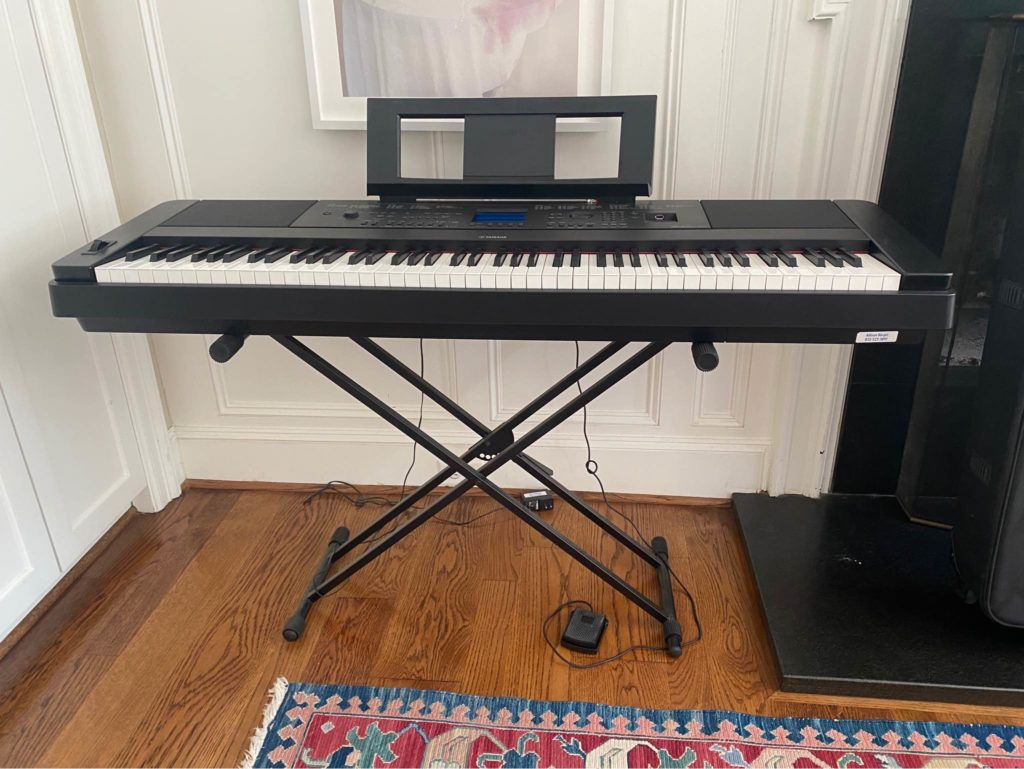
+Tone Generation
The Yamaha DGX-505 uses AWM Stereo Sampling. Back then, this was considered one of the top tone engines available. This is because this tone engine actually plays two samples whenever you press a key. These stereo samples recorded from real instruments added more detail and character to the notes.
So, when compared to other sample-based tone generators of the time, the Yamaha DGX-505 was a great pick. This piano used to give you some of the most realistic and detailed piano tones you’d find on a digital piano.
But again, Yamaha has developed many great tone engines that exceed the AWM Stereo Sampling method.
For example, the DGX-660 uses the Pure CF Sound Engine. This tone generator gets its sound from recordings of Yamaha CF Grand Pianos. The brand used the best recording equipment available to record these samples, which is why the DGX-660 has incredible detail that you won’t find in most pianos.
The Pure CF Sound Engine isn’t Yamaha’s newest engine. However, it’s still one of the best options available today. This tone engine produces very rich, realistic, and bright tones that are almost identical to the sound of an acoustic CF Grand Piano.
This is why I would highly recommend investing in the DGX-660 for its tones, even if it’s the more expensive pick.
+Sound Library
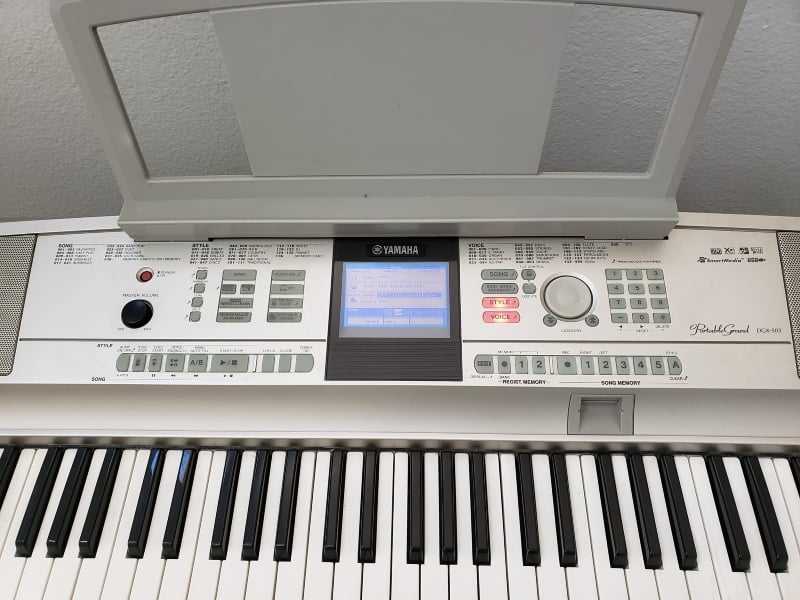
Another benefit of buying the more expensive and newer DGX-660 is a better sound library. This model comes with over 550 great sounds that you can use in your playing. This allows you to play just about any genre of music you want and fit into any band.
On top of that, you can rely on this piano to produce great piano tones. It has a wide selection of piano tones derived from Yamaha CF Grand Pianos. This is a huge plus as you’ll be able to play piano pieces as if you had an acoustic instrument in your hands.
That said, many of the voices on the DGX-660 don’t come from the Pure CF Sound Engine. Most of the non-piano sounds on this instrument come from the XGLite Sound Pack, which contains cool sounds, but some of them aren’t realistic.
On the flip side, the DGX-505 only has around 400 different voices. Sadly, these voices come from the XGLite pack, so you don’t get the same realistic piano tones. That said, you still get a fair amount of variety which is very important for most pianists.
Feel
The winner: Yamaha DGX-660
The next quality I considered was the feel. I tried out both of these pianos and tried to gauge which one felt closest to a real acoustic piano. The DGX-505 doesn’t have weighted keys, while the DGX-660 has graded hammer action keys, so the latter was the clear winner in this category. Again, since the DGX-660 is closer to the high-end models in the DGX line, this didn’t come as much of a surprise.
+Hammer Action
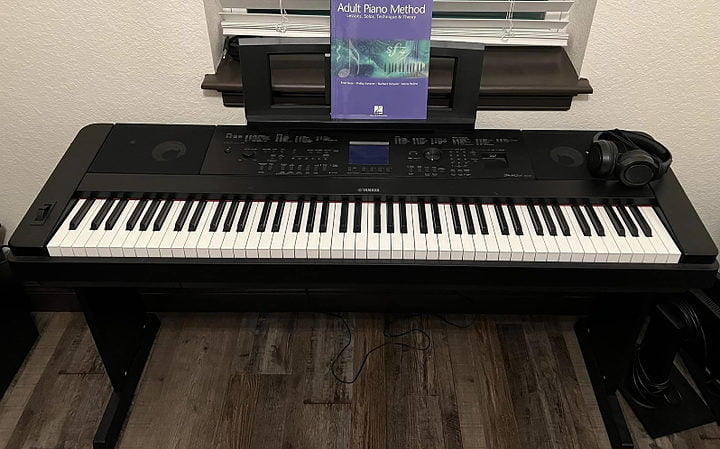
The Yamaha DGX-505 features Graded Soft Touch. If you aren’t getting a piano with fully-weighted keys, this is a cool alternative. This hammer action is great for beginners as the bass keys are heavier than the treble keys, but they aren’t as heavy as an acoustic piano. While this takes away some realism, it makes the piano a bit easier to play, which is great for when you’re just learning the basics.
That said, the more advanced you get, the more you’ll look for fully-weighted keys. So, if you want an instrument that can serve your needs for longer, the DGX-505 may not be the best option.
The DGX–660, on the other hand, uses the Yamaha Graded Hammer Standard (GHS). This type of hammer action is considered one of the best ones on the market as it gives the full weight of the piano while also capturing the subtle weight differences in an acoustic piano’s keys.
This makes the piano feel very realistic and comfortable if you’re used to an acoustic piano. And while you don’t get the spring-back of premium hammer action systems, it’s a great balance between affordable and realistic.
On top of that, the Yamaha DGX-660 features a unique coating on the black keys. This gives a slight textural difference between each key that feels much closer to a real acoustic piano. So, when it comes to a realistic feel, the Yamaha DGX-660 is the clear winner.
Polyphony
The winner: Yamaha DGX-660
The last feature I compared was the polyphony. The Yamaha DGX-505 is a beginner’s piano at this point, so don’t expect the best polyphony. In fact, this piano only has 32-note polyphony, which is only good enough for basic piano pieces. While you can play dense chords and stack notes on top of each other, the notes won’t ring out as long or be as crisp because of the limited polyphony.
The DGX-660 is designed for heavy and professional use, which is why it has 192-note polyphony. With this setup, you can play just about any piece you want and have the notes ring out for a very long time. This allows you more flexibility and versatility in your playing, which is why I highly recommend the DGX-660 over the DGX-505.
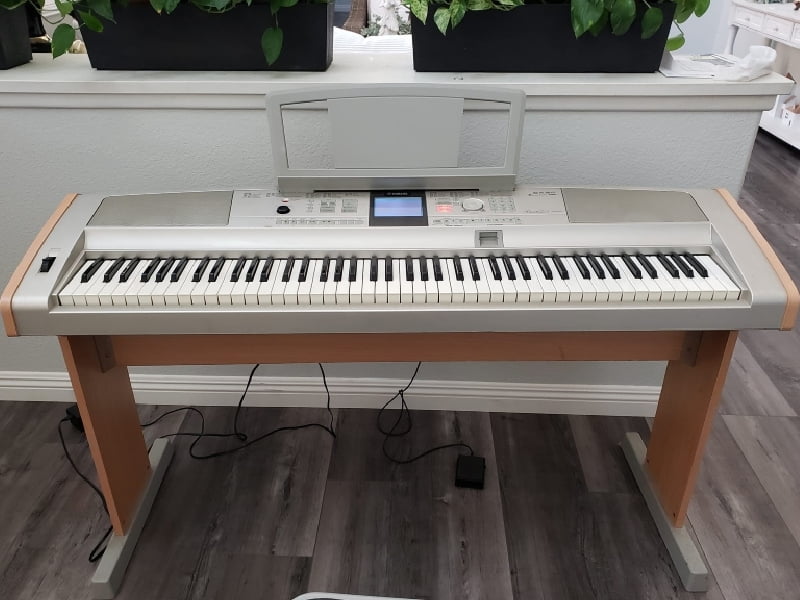
Yamaha DGX-505 vs 660: The Similarities
While the pianos have a lot of differences, they also share a few similarities. For example, they are both portable pianos that you can bring with your anywhere. So, if you have a gig, piano lessons, or a jam session with friends, you can load this piano into a gig bag and easily transport it.
Another feature these pianos share is the built-in reverb and chorus effects. These effects aren’t exactly the best ones you’ll find, but they do allow you to shape your tone a bit more. If you want to have full control over how your piano sounds, this is a very important feature.
That said, even with these similarities, the DGX-660 is still miles ahead of the DGX-505. So, if you’re looking to buy the best digital piano on the market, the DGX-660 will serve you much better.
Quick Rundown of the Yamaha DGX-505
- Notation display - USB connectivity - Large Wave ROM - Backlit LCD - Card slot
Last update on 2025-07-13 / Affiliate links / Images from Amazon Product Advertising API
Quick Rundown of the Yamaha DGX-660
- The Pure CF Sound Engine faithfully reproduces the tone of a meticulously sampled and highly acclaimed Yamaha concert grand piano
- GHS weighted action is heavier in the low register and lighter in the high, just like an acoustic piano
- Score display puts music notation of MIDI songs on the screen, helping you play your favorites by following the bouncing ball
- The Piano room lets you choose from a variety of pianos and acoustic settings to create your own personal piano environment
- The 6 track recorder allows you to capture your performances and song ideas, then add additional layers to spice up your pieces
Last update on 2025-07-13 / Affiliate links / Images from Amazon Product Advertising API
Product Video
Related Articles to Yamaha Dgx 660
- Yamaha YDP-164 vs DGX-660: Why You Should Go for the DGX-660
- Yamaha DGX-660 vs Roland FP-90: Why the Roland FP-90 Is the Better Pick
- Yamaha DGX-530 vs 660: Why the DGX-660 Is the Better Pick
- Yamaha DGX-660 vs DGX-640: A DGX Comparison
- Yamaha DGX-660 vs DGX-630: A DGX Comparison
- Yamaha DGX-620 vs 660: Finding the Best DGX Model
- Yamaha DGX-660 vs YDP-163: Which Is the Better Piano?
- Yamaha DGX-660 vs Roland Juno DS-88: Which Is the Better Piano?
- Yamaha DGX-660 vs Casio PX-360: Which Is the Better Piano?
- Yamaha DGX-660 vs YDP-144: Which Is the Better Yamaha Piano?
- Yamaha DGX-660 vs Korg Havian 30: Which Is the Better Digital Piano?
- Yamaha DGX-660 vs Casio CGP-700: Which Is the Better Pick?
- Yamaha DGX-660 vs YPG-535: Finding the Best Yamaha Digital Piano
- Yamaha DGX-660 vs P515: Is the P515 Worth the Extra Cost?
- Yamaha DGX-660 vs P-115: Which Yamaha Model Is Better?
- Yamaha DGX-660 vs Casio PX-560: Which Piano Offers More Value For The Money
- Yamaha DGX-660 vs 650: A DGX Comparison
- Korg XE-20 vs Yamaha DGX-660: Finding the Best Digital Piano
- Yamaha P45 Vs DGX-660: A Head-to-Head Comparison
- Yamaha DGX 670 Vs 660: The Distinct Difference In Details You Need To Know About
- Yamaha YDP-103 Vs DGX-660: Which Is The Better Yamaha Piano?
- Casio PX-770 Vs Yamaha DGX-660: Should You Get A Portable Or Console Digital Piano?
- Yamaha P71 vs DGX-660: Can the Amazon Exclusive Beat Out the Premium Model?
- Yamaha P125 vs DGX 660 Comparison: Can the P125 Hold Its Own Against the DGX 660?
References:
- Yamaha DGX-505: https://www.zzounds.com/item–YAMDGX505
- Yamaha DGX-660: https://usa.yamaha.com/products/musical_instruments/pianos/p_series/dgx-660/index.html
Lulacruza is an electronic folk duo operating at the junction of the hypermodern and the ancient. Our music weaves together hypnotic female singing, South American folk instruments and electronic processing, while channeling pulsating waves from the source of creation.
Lalucruza is also a community where you can connect with other music lovers to collaborate, exchange ideas and share knowledge. A platform for who wants to learns the basics of playing piano, guitar, drum masters’ technique, etc.. is the premise of our website.
